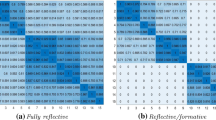Abstract
A new methodology is proposed for the simultaneous reduction of units, variables, and occasions of a three-mode data set. Units are partitioned into a reduced number of classes, while, simultaneously, components for variables and occasions accounting for the largest common information for the classification are identified. The model is a constrained three-mode factor analysis and it can be seen as a generalization of the REDKM model proposed by De Soete and Carroll for two-mode data. The least squares fitting problem is mathematically formalized as a constrained problem in continuous and discrete variables. An iterative alternating least squares algorithm is proposed to give an efficient solution to this minimization problem in the crisp and fuzzy classification context. The performances of the proposed methodology are investigated by a simulation study comparing our model with other competing methodologies. Different procedures for starting the proposed algorithm have also been tested. A discussion of some interesting differences in the results follows. Finally, an application to real data illustrates the ability of the proposed model to provide substantive insights into the data complexities.
Similar content being viewed by others
References
Ball, G.H., & Hall, D.J. (1967). A clustering technique for summarizing multivariate data. Behavioral Science, 12, 153–155.
Bezdek, J.C. (1981). Pattern recognition with fuzzy objective function algorithms. New York: Plenum Press.
Bezdek, J.C., & Pal, S.K. (1992). Fuzzy models for pattern recognition. New York: IEEE.
Bock, H.H. (1987). On the interface between cluster analysis, principal components, and multidimensional scaling. In H. Bozdogan & A.J. Gupta (Eds.), Multivariate statistical modelling and data analysis. Proceedings of Advances Symposium on Multivariate Modelling and Data Analysis, Knoxville, Tennessee, May 15–16, 1986, Dordrecht: Reidel, pp. 17–34.
Caliński, T., & Harabasz, J. (1974). A dendrite method for cluster analysis. Communications in Statistics, 3, 1–27.
Carroll, J.D., & Chaturvedi, A. (1995). A general approach to clustering and multidimensional scaling of two-way, three-way or higher-way data. In R.D. Luce et al. (Eds.), Geometrical Representations of perceptual phenomena. Mahwah, NJ: Lawrence Erlbaum.
De Soete, G., & Carroll, J.D. (1994). k-Means clustering in a low-dimensional Euclidean space. In E. Diday et al. (Eds.), New approaches in classification and data analysis. Heidelberg: Springer Verlag, pp. 212–219.
Gordon, A.D. (1999). Classification, 2nd ed. London: Chapman & Hall/CRC.
Gordon, A.D., & Vichi, M. (2001). Fuzzy partition models for fitting a set of partitions. Psychometrika, 66, 229–248.
Harshman, R.A., Lundy, M.E., & Kruskal, J.B. (1989). A two-stage procedure incorporating good features of both trilinear and quadrilinear models. In R. Coppi & S. Bolasco (Eds.), Multiway data analysis. Amsterdam: North-Holland.
Heiser, W.J., & Groenen, P.J.F. (1997). Cluster differences scaling with a within-clusters loss component and a fuzzy successive approximation strategy to avoid local minima. Psychometrika, 62, 63–83.
Hubert, L., & Arabie, P. (1985). Comparing partitions. Journal of Classification, 2, 193–218.
Kroonenberg, P.M., & De Leeuw, J. (1980). Principal component analysis of three-mode data by means of alternating least squares algorithms. Psychometrika, 45, 69–97.
Kroonenberg, P.M., ten Berge, J.M.F., Brouwer, P., & Kiers, H.A.L. (1989). Gram–Schmidt versus Bauer–Rutishauser in alternating least-squares algorithms for three-mode principal component analysis. Computational Statistics Quarterly, 2, 81–87.
MacQueen, J. (1967). Some methods for classification and analysis of multivariate observations. In L.M. Le Cam & J. Neyman (Eds.), Proceedings of the Fifth Berkeley Symposium on Mathematical Statistics and Probability, Vol. 1. Statistics. Berkeley, CA: University of California Press, pp. 281–297.
Meulman, J.J., & Verboon, P. (1993). Points of view analysis revisited: Fitting multidimensional structures to optimal distance components with cluster restrictions on the variables. Psychometrika, 58 (1), 7–35.
Milligan, G.W. (1985). An algorithm for generating artificial test clusters. Psychometrika, 50, 123–127.
Milligan, G.W., & Cooper, M. (1985). An examination of procedures for determining the number of clusters in a data set. Psychometrika, 50, 159–179.
Tucker, L.R. (1966). Some mathematical notes on three-mode factor analysis. Psychometrika, 31, 279–311.
Van Buuren, S., & Heiser, W.J. (1989). Clustering objects into groups under optimal scaling of variables. Psychometrika, 54, 699–706.
Vichi, M., & Kiers, H.A.L. (2001). Factorial k-means analysis for two-way data.Computational Statistics and Data Analysis, 37, 49–64.
Zangwill, W.I. (1969). Nonlinear programming: A unified approach. Englewood Cliffs, NJ: Prentice-Hall.
Author information
Authors and Affiliations
Corresponding author
Rights and permissions
About this article
Cite this article
Rocci, R., Vichi, M. Three-Mode Component Analysis with Crisp or Fuzzy Partition of Units. Psychometrika 70, 715–736 (2005). https://doi.org/10.1007/s11336-001-0926-z
Received:
Issue Date:
DOI: https://doi.org/10.1007/s11336-001-0926-z




